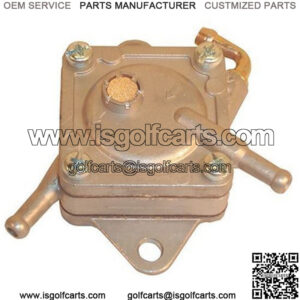First: A Few Basic Facts on Fuel Pumps
Your golf cart’s fuel pump is essentially vacuum-powered using crankcase pressure. While the more generally recognized term “compression” refers to the pressure limits at the top end of the engine, crankcase pressure actually refers to the pressure present at the bottom end, below the piston. While the pistons move up and down, the crankcase pressure will vary; we call this a “pulse.”
What Could Break Down My Fuel Pump?
There are a few issues that can arise involving your fuel pump that would affect your gasoline-powered golf cart or ATV’s performance over time.
Deterioration. Rubber vacuum and fuel lines will eventually deteriorate. If you’re having problems with the fuel not making it to the carburetor, check the lines very closely. Even if you can’t see deterioration, a telltale gasoline smell will let you know that they may have begun to fall apart. Remember: a pin hole or other small area of damage may not be visible, so make sure to check for the fuel smell.
Engine problems. Fuel issues aren’t always caused by the fuel pump. Performance problems could also be caused by issues involving the crankcase or engine. A leaky crankcase or damaged engine cannot produce effective power. You’ll want to take a look for signs of an oil leak, a bad crankshaft seal, or issues with the case gasket.
Debris buildup. Gasoline isn’t exactly the cleanest fuel source there is, and even high-quality fuel may contain dirt, debris, or other contaminants. Over time, this debris can build up and become lodged inside the fuel pump. An inline fuel filter will take care of most of this, but some may still build up, and in order to remove the debris you’ll need to remove the pump itself from the golf cart and disassemble it.
The pumps usually come apart in three distinct sections, with two diaphragms between them. Before taking your fuel pump apart, either draw or scratch a line across each section, so everything can be put back together quickly after cleaning. Clean any corrosion or debris from within the pump, using either gas or a cleaner specially designed for the purpose. Reassemble using the lines you scratched or drew into the pump as a guide.
The final possible issue could be the pump itself. The diaphragms within your fuel pump are fragile, and may break or develop tears with use or lack of maintenance. Over time, the fuel pump’s ability to function will fade and eventually it will stop working entirely. To fix this issue, you’ll need to remove the pump, take it apart, and then replace the diaphragms with a rebuild kit. The diaphragms are the thin sheet of plastic which separate the pieces of the fuel pump.
“Keyword”
“how does a club car fuel pump work”
“how does ezgo fuel pump work”

